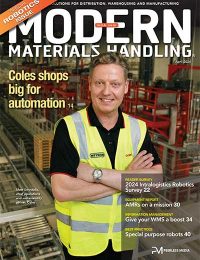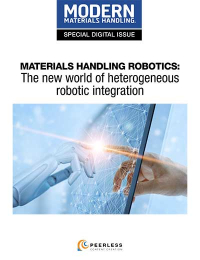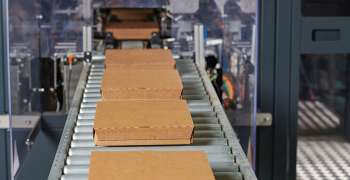Modern’s 5th Annual Salary Survey
Companies are increasingly rewarding hard work by key players in an effort to not only keep them around, but keep them happy.
The results of Modern’s 5th Annual Salary Survey illustrate an industry of experienced, loyal and contented materials handling professionals. At $89,760, the average base salary is the highest in the five years of our survey. Just as impressive: An unprecedented 98% of more than 940 respondents expressed satisfaction with their work. (Read last year’s survey: Materials handling on the uptick.)
But one change we’re seeing following the economic downturn is that individual performance is prized more highly than ever, and incentive strategies once based on increased sales now center on overall company performance.
The current state of materials handling salaries mirrors the rubber band effect of strong industry growth following the economic downturn; now that pent-up demand has been somewhat relieved, compensation in general is returning to normal. However, companies that successfully navigated the recession are rewarding those individuals who helped most, and companies everywhere are ready to pay top dollar for top talent.

Since numbers rarely tell the whole story, we reached out to a random sampling of our survey respondents to get a sense of the people behind the statistics, and to seek their insight into the past, present and future of the materials handling industry job market. According to Ryan O’Connor, warehouse operations and logistics manager for a consumer electronics distributor serving 150 countries, the future is bright indeed.
“Opportunity abounds in this industry,” says O’Connor, who predicts salaries will go nowhere but up. “You have the opportunity to save or cost your company huge money. If you can raise your hand and say: ‘This is what I can do for you. Give me a shot,’ then the sky’s the limit.”
The compensation picture
Thankfully, hiring is much more robust than it was a few years ago, and layoffs have declined sharply. In 2009, 65% of respondents said their company had conducted layoffs or hiring freezes in the previous year. Only 28% were hiring at that time, and just 5% noted pay cuts or salary freezes. For 2012, pay cuts, salary freezes, hiring freezes, benefits reductions, and reduced overtime were more commonly used, with roughly a third of respondents responding affirmatively to each. The good news, aside from a 9% year-over-year drop in respondents whose companies saw layoffs (down to 28% in 2012), is that in almost every case pay-cutting tactics were used 6% less than in 2011, when just 46% said their companies were hiring. This year, that hiring number climbed to 55%.
This year, 58% of respondents said their salary increased in the past year, and 38% said it stayed the same. In our 2010 survey, those figures were reversed. In 2012, the average base salary increase was 5.2%, an improvement upon last year’s 60% of respondents whose salaries increased an average of 4.4% between 2010 and 2011. Of those respondents who saw a salary increase last year, one in eight received increases of 10% or more.
Bonus plans reflect a shifting focus from operational costs and increased sales to the overall performance of the company and that of the individual. In 2009, 47% of respondents indicated bonuses were based primarily on lower operational costs and 45% said they were rewarded based on increased sales. In 2012, those factors were a source of bonus compensation for just 28% and 29% of respondents, respectively. Instead, 69% of respondents now indicated that bonuses are based on whether their company reaches performance goals, and 46% said it is based on individual performance. As late as 2010, those factors rang true for just 18% and 5% of respondents, respectively.

Demographics
Over the last five years of Modern’s salary survey, the average age of the respondent has climbed predictably from 47 to 52. With experience comes better compensation. In 2009, 25% of the survey’s respondents reported earning base salaries of six figures or more. In 2012, that number rose to 30%, with 8% earning $150,000 or more. Fewer employees have faced wage decreases since 2009, when one in 10 respondents saw their salaries reduced by an average of 15% year over year. However, the stakes remain high as just 4% saw decreases averaging 19% in 2012.
Those with supervisory responsibilities can expect to earn 36% more than their non-supervisor colleagues, as compared to the 28% gap between the two groups as captured in last year’s results. Similarly, those with budgetary responsibilities will earn 39% more than those without. Supervisor salaries increased an average of 4.5%, whereas the average salary for a non-supervisor fell by slightly more than 1%. This results in an average base salary of $89,760 for 2012, a 12.3% increase from 2011, while the median salary fell 5.6% to $75,500.
Modern’s first salary survey, published in June 2008, showed median compensation at $80,000, including base salary and bonuses. After that median number dipped as low as $78,000 in 2009 and 2010, it shot back up to $91,000 in 2011, only to settle back at $80,500 this year. The last five years have been difficult for many materials handling professionals, including Dwayne Denton, supply chain manager for Mississippi Sand, a producer and distributor of frac sand for use in the oil and gas service industry.
Denton is working on completing his MBA, as 11% of this year’s survey respondents have already done. Like 77% of respondents, Denton has been with his company for more than 10 years, since before it broke off from its former owner. Back then, he was coordinating the movement of bulk items like asphalt and limestone, and the recession hit very hard. Dwayne survived three layoffs including union and non-union workers, salary reductions from workers to upper management, and a salary freeze that kept his earnings level for more than four years. He finally got a raise this year, and says it was all worth it.
“I’m still trying to recover financially, but I would not have weathered the storm if I were not very happy,” says Denton. “Other than salary, I’m very satisfied. The challenge is awesome. Your customer needs material and you’ve got to figure out how to make it happen. It’s stressful, but it’s the kind of stress I like.”

Job satisfaction
When asked about their futures, 59% see themselves finishing their careers with their current employers, up 6% from last year. Among those who responded “yes,” salaries increased an average of 7.6%. Those who responded “no” saw average salaries remain level, and salaries for those who said they are “unsure” plummeted by an average of nearly 9%.
In 2009 and 2010, just 12% of respondents expressed they were “extremely satisfied,” as compared to 20% in 2011 and again in 2012. The percentage of those “somewhat satisfied” in 2010 rose from 35% to 37% and followed a small increase to 5% in the “not very satisfied” category. Today, just 1% are in that category, with another 1% “not at all satisfied” and just 23% “somewhat satisfied.”

Keith Rhodes counts himself among those who are very satisfied, and he is also likely to recommend a career in materials handling. Rhodes has been in the industry for 15 years, first as a warehouse design engineer, then as an inventory manager, and finally as a director of supply chain management—all for the same company. Rhodes has both supervisory and budgetary responsibilities, and receives a monthly bonus based on sales and profits. His employer is the world’s largest vinyl wrap materials wholesaler into the sign supply industry and has 67 facilities across the United States.
Rhodes quit a career in aerospace engineering working on classified military projects to pursue his true passion: inventory management (supply chain). “My interest was not in being an engineer on a team designing some of the most technologically advanced systems in the United States,” says Rhodes, “It was in inventory management. There is nothing in the world I would rather do.”
Rhodes says he sees an ever-greater interest in materials handling as a profession. He suggested that statistical salary averages and medians might drop as more young talent enters the market, and so cautioned against reading too much into the figures in terms of the overall industry.
“We are in an emerging profession that is catching the attention of everyone from new college students to the boards of some of the largest companies in the world. The addition of young professionals is inevitable and welcomed, but their introduction will give movement in the average salary [as reported in this survey]. That’s the way the math works. But it does not indicate stagnation or reduction of salaries in the materials handling job market in any way,” says Rhodes.
New employees of any age are likely to stick around once they are introduced to materials handling, says Rhodes. It’s the rare case when workers looking for more money or responsibility have to search outside the profession to find it, he says. Besides, Rhodes says a résumé that indicates an employee moves around too much can be an instant deal breaker for some employers. “I don’t see people hopping around a lot once they enter this profession,” says Rhodes. “People are going to secure a job and stay with it.”

The numbers support Rhodes’ feelings, with 41% of respondents indicating no interest in seeking another job—up 5% over last year. The same 37% who said in 2011 they are “open to other possibilities” are still keeping their options open in 2012. Only 16% are passively looking for work elsewhere, 4% less than in 2011. Just 6% are actively looking, and are motivated primarily by compensation (49%), the desire for new challenges (43%), and a lack of advancement opportunities (32%). Rhodes is among those looking passively for ways to advance his career. “I’d like to move up, but I don’t know that it will necessarily be with this company,” he says.
Like Rhodes, O’Connor counts himself among those satisfied with his profession and ready to recommend it to others. He welcomes an influx of college-educated “young blood” into the industry, and encourages his fellow materials handling professionals of all ages to aggressively pursue success. “The opportunity for merit-based pay is huge,” he says. “Simple innovations, relationships, partnerships, and the like all have a real and immediate impact on your company’s profitability.”


Article Topics
Special Reports News & Resources
Automation/Retail Special Issue: Savvy users embrace change Research Report: Use of Automation in Warehouse/DC Special Digital Issue: Warehouse/DC Robotics System Report: Building the world’s best warehouse Top 20 Warehouses 2019 Top 20 automatic identification and data capture suppliers 2019 Top 20 Lift Truck Suppliers in 2019: Market reaches new heights More Special ReportsLatest in Materials Handling
Materials Handling Robotics: The new world of heterogeneous robotic integration Lucas Watson appointed CSO for Körber’s Parcel Logistics business in North America Hyster recognizes Dealers of Distinction for 2023 Carolina Handling names Joe Perkins as COO C-suite Interview with Keith Moore, CEO, AutoScheduler.AI: MODEX was a meeting place for innovation Walmart deploying autonomous lift trucks at four of its high-tech DCs Coles shops big for automation More Materials HandlingAbout the Author
Subscribe to Materials Handling Magazine

Find out what the world's most innovative companies are doing to improve productivity in their plants and distribution centers.
Start your FREE subscription today.
April 2024 Modern Materials Handling

Latest Resources










